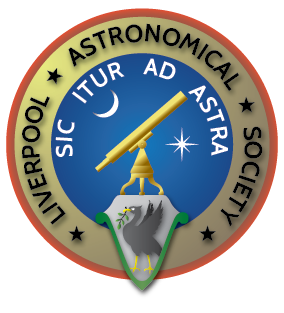Society News Headlines
- May 1st: Mercury is 1.7° South of Jupiter.
- May 1st: Mars at Closest approach to Earth.
- May 5th: Ceres is 0.7° North of Venus.
- May 7th: Neptune is Stationary.
- May 7th: Neptune is 0.9° South of Moon.
- May 8th: Uranus is 0.7° South of Moon.
- May 8th: FAS AGM at Sidmouth, Devon.
- May 9th: BBC’s Sky at Night with Patrick Moore. The Summer Sky. (Rpt May 15th BBC2).
- May 13th: Jupiter is 4° North of Moon.
- May 13th: Mercury is 0.7° North of Moon.
- May 16th: Aldebaran 0.9° South of Moon.
- May 18th: Venus is 6° North of Moon.
- May 21st: Liverpool Astronomical Society AGM at Lecture room. (NMGM) Liverpool Museum 7pm.- Followed by Observational Reports.
- May 22nd: Uranus is stationary.
- May 22nd: Regulus is 0.7° South of Moon.
- May 22nd: Webb Society AGM, at Rutherford-Appleton Laboratory.
- May 22nd: BAA Instruments & Imaging Section Meeting at Humfrey Rooms, Castilian Terrace, Northampton.
- May 25th: Juno at opposition.
- May 25th: Mercury at Superior conjunction.
- May 26th: Mars 5° South of Moon.
- May 26th: BAA Ordinary Meeting at 17:45hrs Savile Row, London.
- May 30th: Venus 4° South of Pollux.
- May 31st: Pluto at opposition.
THE NIGHT SKY DURING THE MONTH OF MAY 1999
Will it be cloudy to-night?, ask the The U.K. Goverment Met Office Weather service. To make your own star chart fo your location at any time, Click Here.
The Sun and Moon
All times are in BRITISH SUMMER TIME (BST). Times For Observer in Liverpool, Merseyside, England, U.K.
Latitude 53 degs 24 mins North.
Longitude +3.0 degs West.
1st 6th 11th 16th 21st 26th 31st SUNRISE 05:38 05:28 05:19 05:11 05:03 04:57 04:51 SUNSET 20:41 20:50 20:59 21:07 21:15 21:22 21:29
| PHASES OF THE MOON DURING MAY 1999 | ||||
| NEW MOON on 15th at 01h:06m |
FIRST QUARTER on 22nd at 06h:35m |
FULL MOON on 30th at 07h:41m |
LAST QUARTER on 8th at 17h:30m |
|
THE PLANETS THIS MONTH.
MERCURY.
Mercury is at superior conjunction with the Sun on the 25th, however it can be seen almost 2° South of Jupiter on the 1st of the month low in the West.
VENUS.
Venus is still riding high in the West after Sunset. Asthis celestial searchlight moves closer to the Earth its apparent size increases from 16″ at the start of the month to 21″ at the end with its phase decreasing to just under half. During May Venus leaves the constellation of Taurus and enters Gemini. Details below give the planet’s conjunctions with some of the brighter objects there. On the 18th at 16h:00m the Moon Passes 6° South of Venus.
- 9th 1.5 degs North of M35 (Open Cluster). 10th 3degs North of Eta Geminorum. 12th 3degs North of Mu Geminorum.
- 17th 41″ North of Epsilon Geminorum. 25th 3degs North of Delta Geminorum. 25th 3degs South of lota Geminorum.
- 28th 2.5 degs South of Upsilon Geminorum. 29th 32″ South of Kappa Geminorum.
MARS.
Mars is a nice evening object,transiting at just before midnight at mid-month. Its diameter decreases slowly as it starts to move away from the Earth. On the 26th at 14h:00m Mars lies 4° South of the Moon. MARSWATCH – latest observations of the red planet.
ASTEROIDS.
- Juno is at opposition on the 24th.
- Ceres is 0.7° North of Venus on May 5th. For More information on Asteroids Click Here.
JUPITER.
By the end of the month Jupiter starts to show again in the morning sky, passing 4°.5 North of the Moon on the 13th in the constellation of Pisces.
Launched in October 1989, the Galileo Jupiter Probe entered orbit around the great planet on December 7th 1995. The Project Galileo Homepage will give you up-to-date information and the very latest images returned.
SATURN.
Saturn is still too close to the Sun for observations.
URANUS and NEPTUNE.
Uranus begins retrograde (Westward) motion during May among the stars of Capricornus. It shines at Mag 5.8.
Positions for the 1st May:
R.A. DEC TRANSIT TIME MAG
22h:17m:07s -16°:29':23" 06h:54m 5.8
Bluish Neptune is also in Capricornus at this time, just two binocular fields west of Uranus. In early May it is less than 1° Southwest of the star Pi Capricorni
Positions for the 1st May:
R.A. DEC TRANSIT TIME MAG
20h:26m:29s -18°:53':21" 06h:04m 7.9
PLUTO.
Best time to look for the almost 14 mag planet is around New Moon. The dates below will be a guide for planning observations.
Positions for May are when pluto's elongation angle is greater than 90°. DATE R.A. DEC TRANSIT TIME May 1st 16h:37m:22s -10°:05':37" 03h:18m May 11th 16h:36m:25s -10°:02':44" 02h:38m May 21st 16h:35m:24s -10°:00':19" 01h:57m
On May 31st Pluto at 13.4 Mag reaches opposition in Ophiuchus. It can be found less than 0.5° North of the star Zeta Ophiuchi. You will need an 8-inch or larger telescope and the best time to see Pluto is when the Moon is not around. It is best seen between May 8th – May 22nd.
S&T Outer Planet Finder Chart.
METEORS.
- May 5th Eta Aquarids (40 per hour) Unfavourable.
- May 13th ALPHA SCORPIIDS (20 per hour) Favourable.
COMETS.
- Comet P/1991 V1 ( Shoemaker-Levy 6) at Perihelion on May 2nd at (1.135AU).
- Comet 37P (Forbes) at Perihelion on May 4th at (1.446025).
- Comet 4P (Faye) at Perihelion on May 6th at (1.6569).
Plus these pages will give daily and weekly reports of this and other Comets progress.
- BAA Comet Section Home Page
- Comet Web Sites.
- NASA/JPL Comet Observations Home Page.
- The Astronomer Comet Page.
OCCULTATIONS.
- May 2nd at 03h:43m Reappearance of Eta Librae
- May 22nd at 00h:21m Disappearance of Mu Leonis
